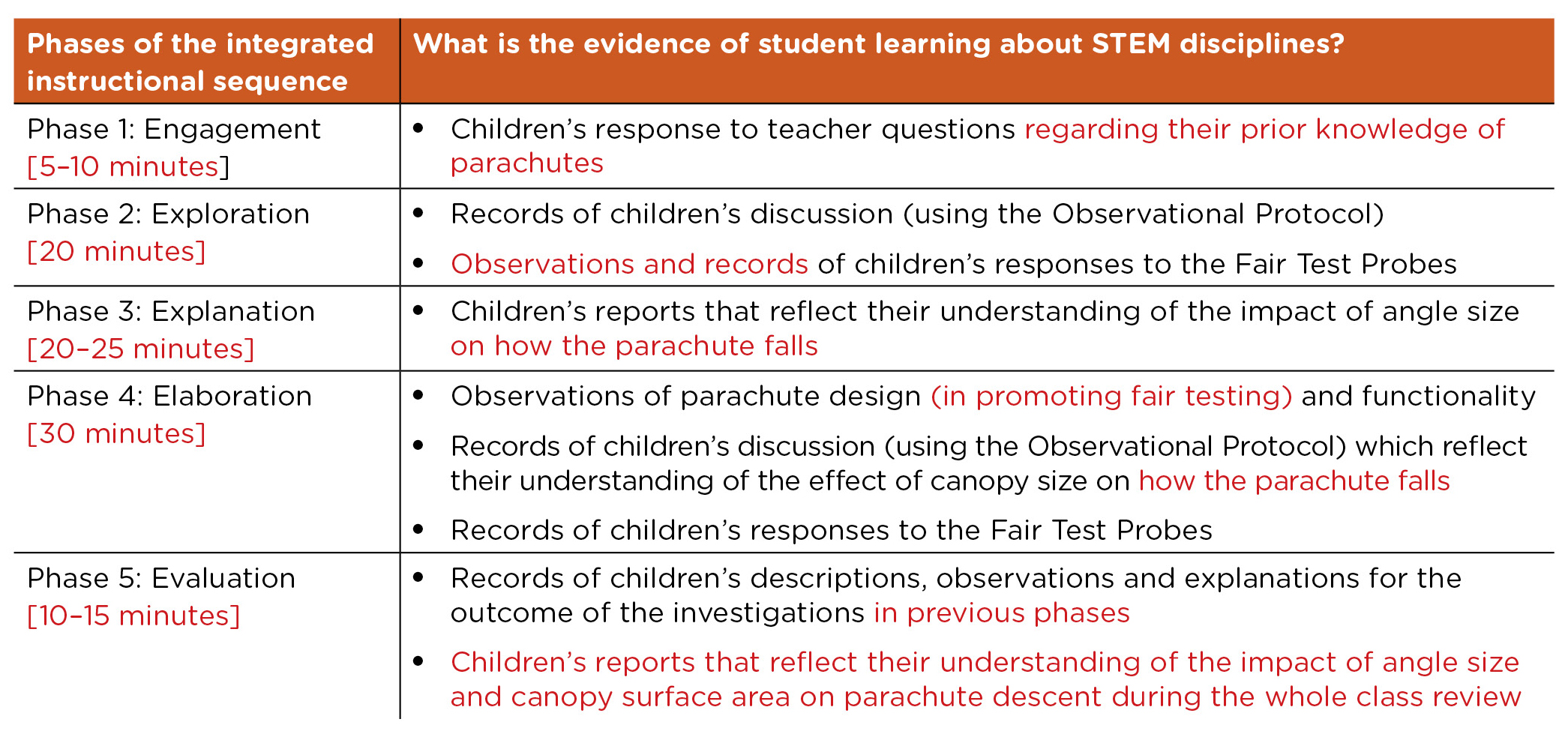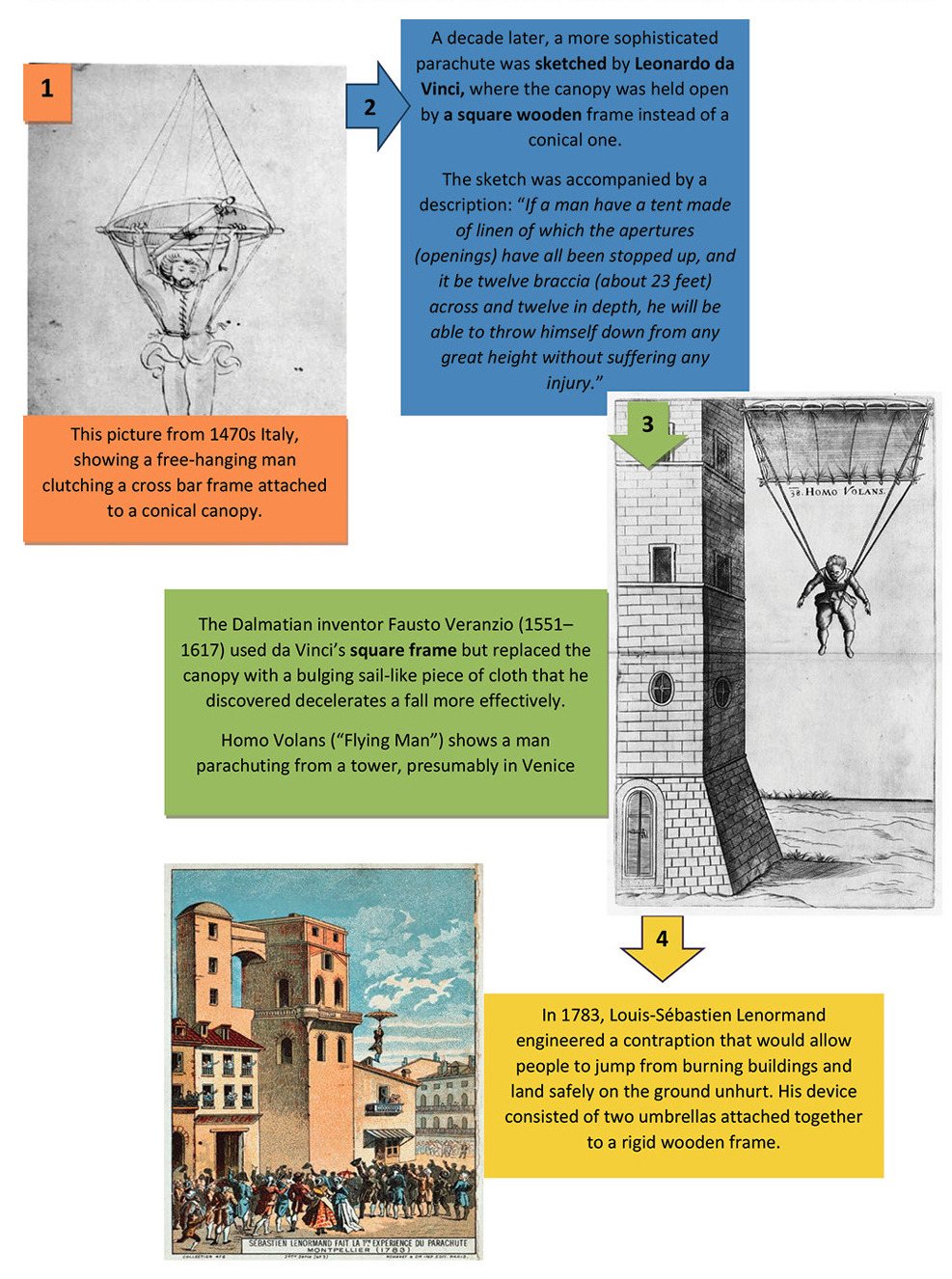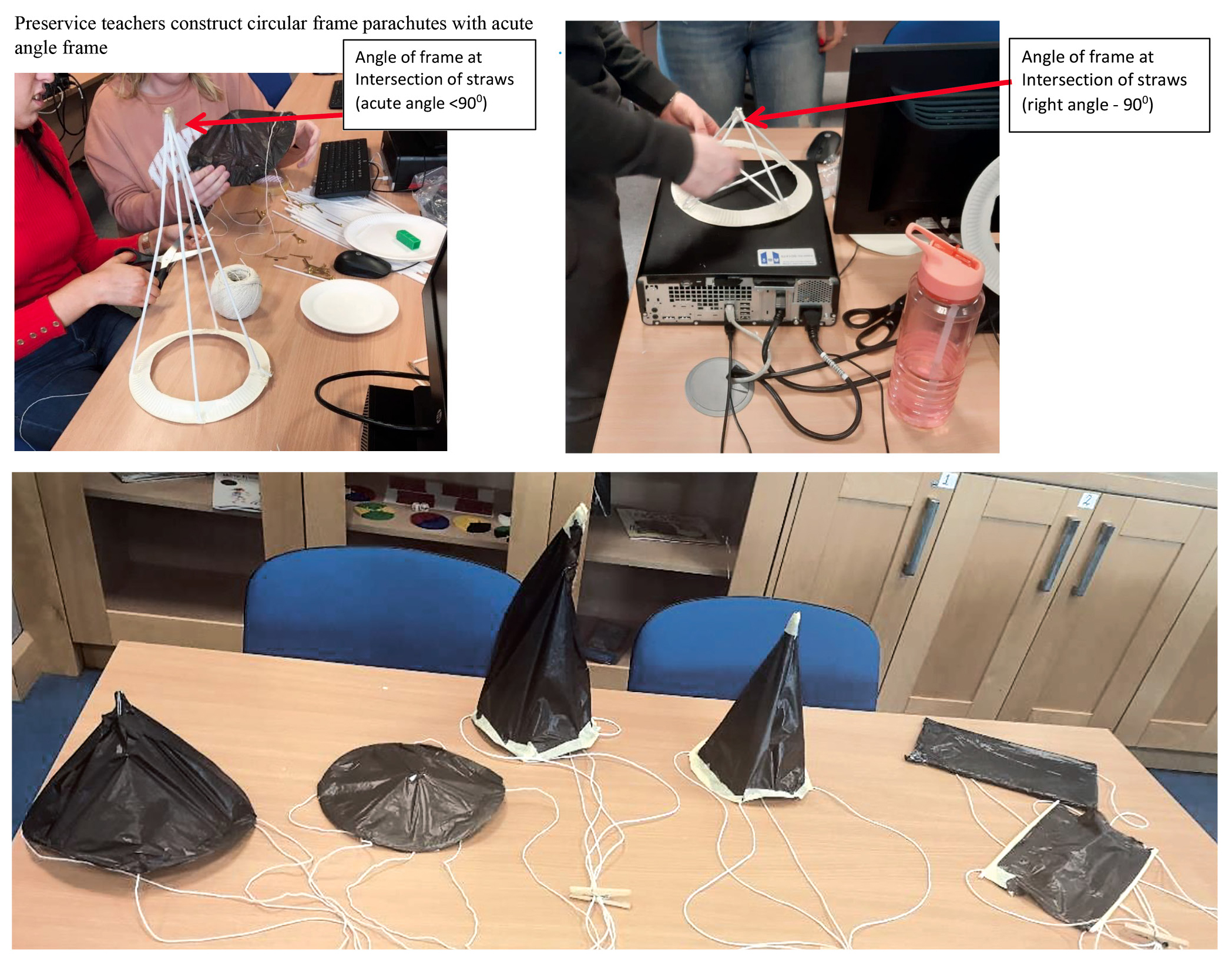feature
How Slow Is Your Parachute?
Reflections on a STEM activity from an Irish classroom
Science and Children—July/August 2021 (Volume 58, Issue 6)
By Aisling Leavy, Mairéad Hourigan, Anne O’Dwyer, Claire Carroll, Edward Corry, and Miriam Hamilton

Local teachers asked us to work with them to design an integated STEM activity for third-grade students (fourth in the United States) that incorporated attention to geometry concepts and provided engagement in science and engineering thinking and reasoning. We share the efforts of two classroom teachers, STEM education faculty at a teacher education college, and 25 preservice elementary teachers to design and implement an integrated STEM activity for two third-grade classes. The teacher education college is located in a city in the southwest of Ireland, and almost half of Irish elementary teachers are accredited through their four-year initial teacher education program. The STEM education faculty have a STEM-outreach partnership with the local elementary school. College faculty, preservice teachers, classroom teachers, and children regulary visit each other’s sites to engage in formal and informal STEM teaching and learning activities across the school year. Children were predominantly English Language Learners in this diverse urban school with 300 pupils and 20 teaching and support staff members.
Being cognisant of the quality indicators for STEM curricula (Guzey, Moore, and Harwell 2016), we incorporated an engineering design challenge, integration of grade-appropriate science and mathematics content, and opportunities for assessment and situated these considerations within a motivating context that supported collaborative work and child-centred practices. The integrated STEM activity incorporated two investigations that sought to develop children’s understanding of fair-testing:
•Investigation 1 – The first parachutes: How does the angle of a parachute frame affect the speed of descent?
•Investigation 2 – Modern parachutes: How does the size of the parachute canopy affect the speed of descent?
The STEM activity was implemented in a third-grade class and a revised version was taught two weeks later to a different third-grade class in the same school. Both classes had a different teacher who lead each of the lessons. Two preservice teachers worked with small groups of four to five children; one facilitated the group activity while the other recorded observations using an “observational protocol” devised for this investigation (Figure 1). We share insights into the approaches and pedagogies that supported children’s learning and report on how opportunities were built in to develop and assess STEM understanding (see Table 1).
Observation Protocol (designed to support preservice teachers’ observations).
Investigation 1 – The first parachutes
Write down what the children notice and say (you may use quotes) about the effect of various angles on the flight of the parachute. These prompts will help you focus your observations:
1. What (formal/informal) angle language did children use?
2. What results did the children predict?
3. Did students have prior knowledge of fair testing?
4. What decisions did children make to ensure that their test was fair?
5. Was their test fair?
6. What results did they get? (Expected or unexpected)
7. Were there any issues with the prototypes they used?
8. Did the activity work as planned? Explain
9. Were the children able to explain how they ensured the test was fair?
10. How did children explain the results?
11. What scientific terminology (if any) was used (e.g., forces, drag, gravity, resistance)?
12. What misconceptions did the children have?
13. Did the children say anything that surprised you?
Investigation 2 - Modern parachutes
Again, write down what children notice and say (you may use quotes) during this section of the activity. These prompts will help you focus your observations:
1. What decisions did children make regarding the parachute design?
2. Did the children focus on fair testing? Did they need prompting?
3. What decisions did the children make to ensure the test was fair?
4. Was their test fair?
5. What challenges did they face with the construction of the parachute?
6. What results did they predict?
7. What scientific terminology (if any) did the pupils use (e.g., forces, drag, gravity, resistance)? What informal language did they use to describe the parachute design and how it fell?
8 What misconceptions (if any) did they demonstrate?
9. Were children able to explain steps they took to ensure their test was fair?
10. What did the children notice about the impact of canopy size on how the parachute fell?
11. How did they measure? Did they order (the parachutes in terms of which fell fastest) or measure time?

Phase 1: Engage
Children’s curiosity was piqued through the projection of large colourful photographs of different shaped parachutes. The teacher elicited prior knowledge relating to parachutes and students responded excitedly, “I use a parachute in my favourite computer game,” “parachutes are so big—as big as a room!” “That would be great fun!” and “You’d have to be brave to jump out of a plane.” On asking students, “What are parachutes for?” children immediately focused on the importance of safety and slow descent: “It needs to come down slowly or you could get hurt” “Yeah, you would want a safe landing!” As part of a whole-class discussion, the teacher explained that parachute designs had changed since their invention and reviewed the first parachute designs (Figure 2), emphasizing changes to the shape of parachute frames and canopies over time. Illustrations supported descriptions of 15th century designs using a circular frame and conical canopy, the square wooden frame designs of Leonardo da Vinci in the 16th century, Fausto Veranzio’s development of a bulging canopy using da Vinci’s square frame, and culminated with Louis-Sebastien Lenormand’s (the first witnessed descent with a parachute in 1783) design using a pair of modified umbrellas.

Phase 2: Explore
Groups of four or five children worked alongside two preservice teachers to develop a fair test to investigate: How does the angle of the parachute frame affect the speed of descent?
Parachutes were made previously by preservice teachers using common househould items (approximate cost $5 for class set). Each frame consisted of the outer rim consisting of a paper plate (circular base) and four paper straws, plus one refuse bag (canopy) held together using sticky tape. Four pieces of string were attached at equidistant points on the circular base and attached to a cube (representing the load). The angle of intersection of the straws with each other at the peak of the canopy was used to determine the angle (see Figures 3a–c). Each group was provided with four pre-constructed circular frame parachutes with an acute angle (<90 degrees), right angle (90 degrees), obtuse angle (>90 degrees) and straight line angle (180 degrees). In this explore phase, the teacher’s role was to elicit and record children’s thinking when exploring parachute frames (Figure 4), designing fair tests, and making predictions.

List of probes for use during Fair Test discussions.
These probes may be useful to draw children’s attention to particular aspects of fair testing:
- How are you going to compare the various parachutes?
- How will you make sure the test is fair? What will you do?
- Why is that important?
- Where will you hold the parachutes? How will you hold the parachutes (1 or 2 hands)?
- From what height will you drop the parachutes?
- How will you know which drops slowest or fastest?
Some children initially used informal language, rather than formal mathematical terminology, when describing angles. They referred to the parachute frames being “different because they are not all straight, they are bent” and described frames with acute angles as “sharper angles,” obtuse angles as “wider,” and straight angle frames as “not having any corners at all.” Others, used correct mathematical terminology, e.g., acute, obtuse, right and straight angles. Our observations suggest that as a result of hearing their peers using mathematical terminology, alongside our own revoicing of these children’s mathematical language, most children quickly and easily adopted the use of formal mathematical terms.
Groups deliberated about how to carry out a fair test of the effect of the frame angle on the speed of descent. We used three pointers as a scaffold to guide children in planning their fair test: Change, Same, and Measure.
CHANGE (one thing)
Keep everything else the SAME
MEASURE—what will you record or observe?
We were changing just one thing (angle of frame) and keeping everything else the same (shape of the parachute frame (circular), length of string, height to drop, load, testing conditions). In terms of measurement, as the drop was one to two seconds, accurate timing was difficult. We predicted that children would likely decide to observe and record which parachute falls fastest/slowest and repeat the recording over a number of trials (to confirm results).
On the first occasion, many of the children launched too quickly into predicting and testing without adequate consideration of fair testing. Consequently, for the second implementation, we provided preservice teachers with probes to support children when articulating their ideas. These probes were effective in causing children to pause and consider aspects of fair testing; resulting in consideration of a wide number of factors when designing the fair tests.
This dialogue extract illustrates how preservice teachers scaffolded children in ensuring the parachutes are dropped from the same height. A similar probing strategy was used to facilitate the children’s observation that all parachutes had the same material, string length, load, etc.
Preservice teacher: How will we make sure it is a fair test?
Child 1: Make sure all the same things happen at the same time.
Child 2: We have to hold the parachutes level (gesturing with hands).
Preservice teacher: Why is that important?
Child 2: ’Cause if one is higher up, it will drop the slowest because it has more air getting in to it and it’ll start further away from the floor.
Child 3: I’ll count down from five and everyone drop them at the same time.
The groups made predictions about which parachutes might descend fastest. Predictions acted as an informal assessment of children’s developing STEM understandings. Some responses revealed misconceptions around the mechanics of flight (“this parachute looks like it has the most material so it’ll fall faster cause it’s the heaviest”) and about the role played by the angle in relation to speed of descent (“the acute angle will fall the slowest cause it gets the most air trapped inside”). Using the criteria established within the groups for a fair test, children then tested their four parachutes by either dropping all parachutes together or dropping them in pairs to facilitate their observations.
Phase 3: Explain
After allowing time for children’s exploration with the fixed frame parachutes, the teacher showed images and a video from SciShow kids (Playtime with parachutes, physics for kids https://youtu.be/Ab_g5sLoXoY). The purpose of this was to informally introduce relevant vocabulary and animations to help the children visualize the relevant concepts, e.g., the presence of air (as matter) and air resistance (described as drag) causing the rate of descent to slow down. The particular nature of matter in air, gravity, and air resistance were not explicitly dicussed in this lesson, as the focus was on children’s fair test investigation skills. However, the introduction of the vocabulary and illustrations provided scaffolding for children’s descriptions during the class dicussion.
The teacher then coordinated a class discussion. Each group described the parameters of their fair test and provided a rationale for their predictions, using some of the newly introduced language to support their descriptions.
When reporting the outcome of the parachute drop, groups were required to relate the test outcome to the angle of the parachute frame and the consequent reprecussions for the speed of descent. The reporters demonstrated accurate use of mathematical language and in-depth understandings of fair testing. The teacher’s use of probing questions such as, “Why do you think that happened?” supported students in articulating understanding of the science principles of air resistance to the observations in the testing situations. Children’s responses provided opportunities for informal assessment.
Group 1: We learned which one comes down slow and which ones come fast.
Teacher: Was your prediction correct?
Group 1: No [laughs]! We thought the right angle one could be slowest cause it would catch more matter. But we were wrong!
Teacher: What did you find?
Group 1: The flat parachute, the straight angle one, comes down slowest and it’s the best .... cause it was able to trap more air in it.
Group 3: We were right. Our straight angled parachute fell slower... cause it had more drag.
Group 6: Yeah, the same. The flat one was the best—it’s wider and catches more matter and has more drag.
Phase 4: Elaborate
In order to extend understanding of fair testing and develop engineering design skills, the elaborate phase focused on an investigation of modern-day parachutes and required children to apply their understanding from the previous investigation.
Within a whole-class discussion, the teacher presented images and videos of a variety of modern-day parachute shapes (round, cruciform, ram-rectangular), sizes (large, small), and functions (competitive skydivers, military). The mechanics of how parachutes work (canopies, suspension lines, harness) and the effect of shapes on maneuverability (e.g., dome shapes have lower maneuverability than rectangular shapes) were also explored. Reference was made again to the effect of drag and air resistance on parachute canopies; there was no explicit reference made to the effect of canopy shape or size.
In groups, children were invited to plan, design, and make a modern-day parachute using black refuse sacks (trash bags), string, a cube (to represent the load), and tape. The purpose of the activity was to use fair testing to investigate: “How does the size of the parachute canopy affect the speed of descent?” Once the shape was determined (circular/rectangular), each group made four different size canopies and made predictions regarding their speed of descent.
Discussions about how to carry out a fair test were similiar to the circular frame parachute deliberations with slight modifications based on observations and feedback from groups in phase 3 (“We’ll stand on the stage this time because there is a bigger drop”). The engineering design was negotiated between the children and focused on aspects that they needed to keep the same, such as the number of strings, location of strings on canopy, and method of attachment of strings to the load. Redesigns, when they happened, usually involved increasing the number of strings.
The first occasion we carried out this activity, group discussions tended not to focus on the engineering design process such as decisions regarding the engineering problem and the pending investigation, e.g., methods of ensuring a fair test. Instead, children chatted about parachute aesthetics and load characteristics (“You could have a big picture on it,” “We could make a costume for the jumper”) and the positioning of the load/jumper (upside down, two jumpers together). To maintain the focus on higher-order thinking around STEM concepts and in particular the need to ensure fair testing, we generated a set of probes to promote the focus on STEM thinking when constructing the parachute design and making predictions (see Figure 5). Initial responses to, “What are you exploring in this investigation?” referred to the engineering elements, with responses such as “making a parachute,” “trying to cut out a large rectangle shape canopy” and “tying the strings to the parachute.” Responses to the probe “Tell me about your investigation” promoted a focus on the STEM inquiry, as evident in replies such as “investigating if bigger or smaller parachutes fall faster” and “figuring out if bigger canopies fall slower or faster.” In response to the probe “How will you ensure you have a fair test when making the parachute?” children were clear regarding what was needed “They will all have four strings and one cube, only the size [pointing to the plastic] will be different.”
Students’ predictions revealed a variety of understandings ranging from emerging to more sophisticated. A few children still demonstrated misconceptions about the role of variables such as size of parachutes (“the bigger one will drop faster because it’s heavier”) whereas others, despite providing incorrect predictions, demonstrated promising understandings of the relevant concepts (“the smaller parachute will drop slower because it will fold over and catch more air”). Some children provided accurate predictions but did not articulate a rationale (“the bigger circle will fall slower .. because its bigger” and “the bigger one will be more effective”) whereas about half managed to coordinate their understandings of how the larger size caused more drag, because there was more air resistance slowing down the descent (“the bigger one will trap more air and fall slower” and “the bigger will win because it has more of it and that’ll mean more drag so it’ll be real real slow”).
Applying their group’s established fair test criteria, each group tested their four parachutes while discussing and generating explanations for their observations. When working with the first class of third graders, we noticed the tendency of some children to request explanations from the preservice teachers to explain their observations. Consequently, we devised a series of prompts to support preservice teachers when responding to children’s questions (Figure 6). Thus, our intent was to maintain the children’s higher-order thinking by focusing on their explanations to ensure fair testing while engaging in inquiry around their emergent science understandings.
Probes for the engineering-design aspect of the STEM activity.
Questions that ask children about what they are doing
- What are you exploring in this investigation?
- You are doing lots of work, tell me about your investigation.
Questions that focus children on making predictions
- What do you think will happen next?
- What do you think will happen if …?
- What else could you do to ….?
Questions that focus children on fair testing
- How will you ensure you have a fair test when making the parachute?
Prompts to maintain higher order thinking when discussing outcomes of a STEM investigation.
In response to a question such as Why did the smaller parachute fall faster? you might:
1. Restate or almost restate the question as a response.
Example: “Yes, the smaller parachute falls faster.”
2. Admit ignorance or present information.
Example: “I am not sure why that happens, but that’s a good question. What do you think?”
3. Encourage brainstorming or consideration of alternative explanations.
Example: “Why does the smaller parachute fall faster? Let’s brainstorm some possible answers with people in your group.”
4. Encourage consideration of alternative explanations and a means of evaluating them.
Example: “Now how are we going to try to figure out why the smaller parachute falls faster? Where would we find that information? Let’s think back to the video earlier. Was there anything there that might help us answer that question?”
5. Encourage a means of evaluating their explanations.
Example: “Let’s test it out what you think using the parachutes. Then we will talk about it again and check.”
Phase 5: Evaluate
Our evaluation was based on evidence gathered from observations made during each phase of the activity, recorded on the observational protocols, of what children said within small groups and within the whole-class discussions. This formative assessment of learning was facilitated by the design and use of observation protocols. Observation protocols, in the engage and explain phases, supported evaluation of children’s scientific and mathematical language use, their misconceptions, and their developing understandings of the STEM concepts. Specific insights into understandings of fair testing in the explore and elaboration phases and engineering design in the explore phase were facilitated through the use of probes. While these were used by preservice teachers in our study, teachers who wish to engage in this type of investigation in the future could informally use these observational protocol prompts and probes to inform their focus when observing and interacting with children during both group work and whole-class discussions.
At the end of the inquiry, as part of the evaluate phase, children were encouraged to share their new learning. As part of a whole-class review, the teacher coordinated a discussion encouraging groups to report their investigation findings. Evidence of children applying understandings from the prior parachute investigation was demonstrated in their references to drag in slowing the descent:
“Big one went real slow because there was more of the parachute to catch the air”
“The small parachute went fastest because there wasn’t as much drag cause it was smaller”
“The bigger the parachute the more matter that was captured when it was falling down. So it was slower”
“The larger the shape the slower the fall—it’s all about the drag”
“It’s like the parachute and the air are having a fight and when there is more parachute there is more to fight...so the bigger one will fall slower”
Conclusion
This activity showcases efforts at meaningful integration of the STEM disciplines embedded within our “Design a Parachute” inquiry. Our use of the Guzey et al. (2016) quality indicators for STEM curricula was a valuable tool in our design considerations. Furthermore, data from the observation protocols of the first teaching of the activity identified challenges maintaining higher-order thinking. Subsequently, we designed a series of probes to guide novice preservice teachers in maintaining the higher-order thinking of children when deliberating about fair tests, making predictions, and reasoning about observations arising from their investigations. Children engaged enthusiastically with the tasks and developed knowledge and understanding of the science, mathematics, and engineering design process. Engaging collaboratively with their peers also supported their adoption and development of disciplinary language and provided an enjoyable and worthwhile learning experience that supported them in accessing understandings of aspects of life around them.
Teachers commented that if carrying out the STEM activity without the support of others, they would devote one entire science lesson to each of the 5E components and incorporate reflective journaling activities to better capture the learnings of all children. The integrated STEM activity offers many opportunities for differentiation. It was specifically designed for English Language Learners and the use of video, hands-on activities, and mixed language-ability groups provided sufficient support for children. Furthermore, teachers may differentiate content to match children’s level of understanding of fair testing by providing children with choices of the number of angle frames to compare or by using additional resources and delivery formats, e.g., demonstration, animations, and fair testing templates. Differentiating in terms of the process might include offering different amounts of support through flexible grouping arrangements, building in additional time to reflect on the learning activities through pedagogies such as journaling, partner talk, or think-pair-share. Alternatively, consider establishing stations to allow for independent activities or exploration with different materials, e.g., different groups could carry out different fair test investigations by varying what is “kept the same” and what “changes.” Providing variety and choice in the ways children can demonstrate their understandings, such as demonstration of parachute drops or verbal/written/visual reports outlining fair testing decisions, will support differentiation of product. Finally, this STEM lesson provided potential for further integration with history, specifically, the inventions and changes over time. ●
Aisling Leavy (aisling.leavy@mic.ul.ie), Mairéad Hourigan, Anne O’Dwyer, Claire Carroll, Edward Corry, and Miriam Hamilton teach at Mary Immaculate College in Limerick, Ireland.


